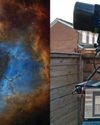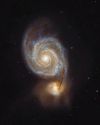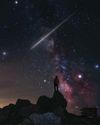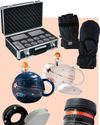
This month, we'll take a closer look at the cosmic microwave background. Sometimes called 'the afterglow of creation', this extremely faint microwave glow is considered one of the most convincing pieces of evidence for the Big Bang theory. But how is it that we are still observing this ancient light?
As we've seen in earlier parts of this series, space is expanding. Since the amount of matter in the Universe remains fairly constant, the increasing volume means that the average density of cosmic matter is decreasing over time. That means the density of the Universe must have been much higher in the distant past.
Right after the Big Bang, before there were any galaxies, stars or planets, elementary particles were packed almost shoulder to shoulder, and the corresponding temperature was unimaginably high. This hot, dense plasma produced energetic radiation. However, individual light particles - photons - have trouble traversing such plasma-filled environments, as they are continuously absorbed (and re-emitted) by charged particles like electrons. In other words: the hot, early Universe was opaque.
Cosmic treasure trove
Leftover radiation from the explosion is key to unlocking the Universe around us
Esta historia es de la edición May 2023 de BBC Sky at Night Magazine.
Comience su prueba gratuita de Magzter GOLD de 7 días para acceder a miles de historias premium seleccionadas y a más de 9,000 revistas y periódicos.
Ya eres suscriptor ? Conectar
Esta historia es de la edición May 2023 de BBC Sky at Night Magazine.
Comience su prueba gratuita de Magzter GOLD de 7 días para acceder a miles de historias premium seleccionadas y a más de 9,000 revistas y periódicos.
Ya eres suscriptor? Conectar

Putting cosmic rays to work
These penetrating interstellar particles have applications from astronomy to archaeology

Set up your first imaging sequence
How to automate and coordinate your gear over multiple nights of imaging

The Universe without gravity
Life with no gravity might sound a fun idea, but as Govert Schilling explains, shutting off this pivotalforce would spell disaster for Earth and beyond

How to blend images taken with different camera setups
Combine data captured at varied focal lengths to create rich, deep images

INSIDE THE SKY AT NIGHT
Back in September 2021, The Sky at Night show spoke to Carly Howett about NASA's then upcoming Lucy mission. As the spacecraft now approaches its main targets - the Trojan asteroids - we check in with her to see how the mission is going

The science of SCI-FI
We love a good sci-fi film, but do they get the science right? Amy Arthur picks six of the big mistakes made in space films

Seeing in a new light
It's National Astronomy Week this month, so take a tip from Mark Westmoquette and let mindful stargazing change your perspective on your life and problems

What to do if you find a meteorite
Ever come across an unusual rock and wondered if it's a meteorite? Mark McIntyre explains how to tell if that stone really is a fragment from outer space

GEAR
Charlotte Daniels rounds up the latest astronomical accessories

Q&A WITH A STELLAR ECLIPSE SPECIALIST
Many stars are gravitationally locked inside multi-star systems, but a rare new triple-star system has set a new record for how cosy these clusters can get